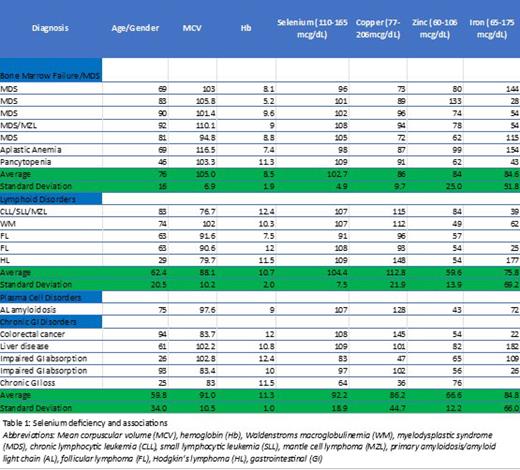Background
Selenium (Se) is an essential micronutrient with roles in reproduction, metabolism, immunity, and the cellular cycle, including DNA synthesis and prevention of cell death. Its role in malignancy has also been studied, specifically for esophageal, gastric, lung, prostate cancer. Studies have shown benefit with Se supplementation for those malignancies. There is evidence that low Se levels are independently associated with worse outcomes regarding treatment response and long-term survival for Non-Hodgkin's Lymphoma (NHL) and cutaneous T-cell lymphoma, and additional studies on its association in acute myeloid leukemia (AML), follicular lymphoma (FL), and Hodgkin's lymphoma (HL) have revealed worsening outcomes as well. However, Se was not predicative of treatment response or survival for AML, FL and HL, therefore it's role in the development of hematological malignancies is not clear. Previously, the role of Se in myelodysplastic syndrome (MDS) was investigated, indicating the importance of Se for apoptosis in MDS cell lines. There is evidence that a causal relationship with decreased Se levels and chronic anemia might exist; however, there is a paucity of data regarding its role in the development of chronic anemia and hematological disorders.
This descriptive single center study describes Se deficiency in patients with chronic anemia.
Objectives
Primary endpoint was to determine if there was evidence of Se deficiency in patients with chronic anemia in an academic hematology outpatient clinic.
Methods
We herein present a descriptive study on 18 patients with hematological disorders and selenium deficiency. Upon initial detection of Se deficiency, levels of hemoglobin (Hb), mean corpuscular volume (MCV), Copper (Cu), Zinc (Zn) and iron (Fe) closest to time of detection were noted if tested. Average values with standard deviation were calculated and association with malignancies were noted.
Results
Of the 18 patients, 13 had pre-malignant or malignant conditions, including 7/13 who had bone marrow failure/MDS, 5/13 patients with lymphoid disorders, and 1/13 with plasma cell disorders. The 5 remaining patients had chronic gastrointestinal disorders. Averages on detection of Se deficiency were noted to be: Hb (9.9 ± 2.0), MCV (96.0 ± 11.2), Se (100.5 ± 11.6), Cu (95.8 ± 28.8), Zn (70.1 ± 21.5) and Fe (81.6 ± 56.7). No association was noted between Se and other trace elements. 72% (13/18) of patients with Se deficiency also had malignant conditions. Of those with malignancy, 54% were noted to have bone marrow failure.
Discussion
Currently there are no clinical guidelines that recommend following levels of Se routinely in patients with chronic anemia. Our data might indicate a possible association between chronic anemia and Se deficiency. Given the high number of MDS patients in our study, there might be a link between Se deficiency and MDS. Further investigation is warranted into the role of Se in the development of chronic anemia disorders, as supplementation with Se and routine follow-up may be warranted and can improve clinical outcomes.
Disclosures
Akhtari:BMS: Membership on an entity's Board of Directors or advisory committees, Speakers Bureau; Incyte: Speakers Bureau; CTI: Speakers Bureau; JazzPharma: Speakers Bureau; Sobi: Honoraria; Karyopharm: Speakers Bureau; PharmaEssentia: Speakers Bureau; J&J: Speakers Bureau; Abbvie: Honoraria; SecuraBio: Speakers Bureau; Incyte: Speakers Bureau.


This feature is available to Subscribers Only
Sign In or Create an Account Close Modal